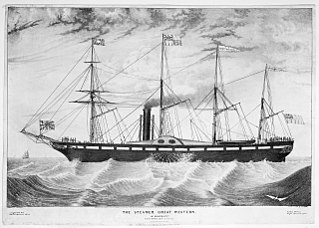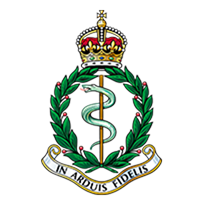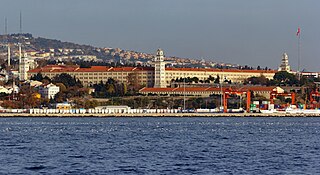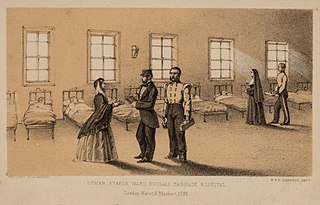
Renkioi Hospital was a pioneering prefabricated building made of wood, designed by Isambard Kingdom Brunel as a British Army military hospital for use during the Crimean War.

Renkioi Hospital was a pioneering prefabricated building made of wood, designed by Isambard Kingdom Brunel as a British Army military hospital for use during the Crimean War.
During 1854 Britain entered into the Crimean War, and the old Turkish Selimiye Barracks in Scutari became the British Army Hospital. Injured men contracted illnesses—including cholera, dysentery, typhoid and malaria—due to poor conditions there. [1] After Florence Nightingale sent a plea to The Times for the government to produce a solution, the British government were alarmed by the revelation of the appalling state and statistics of military hospitals in the first phase of the war.

In February 1855, Isambard Kingdom Brunel was invited by the Permanent Under Secretary at the War Office, Sir Benjamin Hawes (husband of his sister Sophia), to design a pre-fabricated hospital for use in the Crimea, that could be built in Britain and shipped out for speedy erection at a still-to-be-chosen site. [2]
Brunel initially designed a unit ward to house 50 patients, 90 feet (27 m) long by 40 feet (12 m) wide, divided into two hospital wards. The design incorporated the necessities of hygiene: access to sanitation, ventilation, drainage, and even rudimentary temperature controls. [3] These were then integrated within a 1,000-patient hospital layout, using 60 of the unit wards. [4] The design took Brunel six days in total to complete. [5]
From 1849 Gloucester Docks-based timber merchants Price & Co. became involved in supplying wood to local contractor William Eassie, who was supplying railway sleepers to the Gloucester and Dean Forest Railway. Eassie's company diversified after the railway boom period, manufacturing windows and doors, as well as prefabricated wooden huts to the gold prospectors in Australia. [4] As a result, when the Government wanted to provide shelter to the soldiers in the Dardanelles, Price & Co. chairman Richard Potter had tendered to supply Eassie design as a solution, and gained a 500-unit order. [4] Potter then travelled to France and obtained an order from the French Emperor for a further 1,850 huts to a slightly modified design.
French Army soldiers arrived in Gloucester Docks in December 1854 to learn how to erect the huts. Supply was delayed by the need to transfer the resultant packs from broad-gauge GWR to standard-gauge LSWR tracks, with the last packs shipped from Southampton Docks in January 1855. [4]
Having worked with Eassie on creating the slipway for the SS Great Eastern , [6] Brunel approached Price & Co. about producing the 1,000-patient hospital. The last of the units was shipped from Southampton on one of 16 ships, less than five months later. [4] [7]
In January 1855, the Government had selected Dr Edmund Alexander Parkes to travel to Turkey to select a site for the hospital, organise the facility, and superintend the whole operation. Parkes had selected Erenköy on the Asiatic bank of the Dardanelles near the fabled city of Troy. This was located 500 miles (800 km)—then three or four days' journey—from the Crimea, but importantly outside the malaria zone in which Scutari was located. [8] Parkes remained on-site until the end of the war in 1856. [9]
After William Eassie Snr had seen the awful state of construction of the previously shipped British Army huts at Balaklava, he sent his son to supervise the construction of the hospital. [4] The whole kit of parts had reached the site by May 1856, and by July was ready to admit its first 300 patients. Although hostilities had ceased in April, by December it had reached its capacity of 1,000 beds, [5] scheduled to expand to 2,200. [3]
Renkioi was designated a civilian hospital, under the War Office but independent of the Army Medical Department, and hence outside the management of Florence Nightingale. It had a nursing staff selected by Parkes and Sir James Clark, including as a volunteer Parkes's sister; [10] while other staff included Dr John Kirk, later of Zanzibar fame.
Run as a model hospital, it "demonstrated the best practices of the age". This was in contrast to the Army medical facilities, which between them had two clinical thermometers and one ophthalmoscope. Also, despite the Royal Navy's success in preventing scurvy through the provision of concentrated fruit juice, the army failed to learn the same lesson, and so its Crimean soldiers suffered from scurvy.
Renkioi Hospital however had a short life. It received its first casualties in October 1855, after the fall of Sevastopol, was closed in July 1856, and was sold to the Ottoman Empire in September 1856. [11]
But even for such short used institutions, it was feted as a great success. Sources state that of the approximately 1,300 patients treated in the hospital, there were only 50 deaths. [12] In the Scutari hospital, deaths were said to be as many as 10 times this number. [3] Nightingale referred to them as "those magnificent huts". [13]
Today almost nothing survives from it, although regular tourist trips do take in the site.
The practice of building hospitals from prefabricated modules survives today, [8] with hospitals such as the Bristol Royal Infirmary being created in this manner.

Florence Nightingale was an English social reformer, statistician and the founder of modern nursing. Nightingale came to prominence while serving as a manager and trainer of nurses during the Crimean War, in which she organised care for wounded soldiers at Constantinople. She significantly reduced death rates by improving hygiene and living standards. Nightingale gave nursing a favourable reputation and became an icon of Victorian culture, especially in the persona of "The Lady with the Lamp" making rounds of wounded soldiers at night.

SS Great Western was a wooden-hulled paddle-wheel steamship with four masts, the first steamship purpose-built for crossing the Atlantic, and the initial unit of the Great Western Steamship Company. Completed in 1838, she was the largest passenger ship in the world from 1837 to 1839, the year the SS British Queen went into service.

Mary Jane Seacole was a British nurse and businesswoman.

The Royal Army Medical Corps (RAMC) is a specialist corps in the British Army which provides medical services to all Army personnel and their families, in war and in peace. The RAMC, the Royal Army Veterinary Corps, the Royal Army Dental Corps and Queen Alexandra's Royal Army Nursing Corps form the Army Medical Services.

Samuel Evans VC was a Scottish recipient of the Victoria Cross, the highest and most prestigious award for gallantry in the face of the enemy that can be awarded to British and Commonwealth forces.

The Royal Victoria Hospital or Netley Hospital was a large military hospital in Netley, near Southampton, Hampshire, England. Construction started in 1856 at the suggestion of Queen Victoria but its design caused some controversy, chiefly from Florence Nightingale. Often visited by Queen Victoria, the hospital was extensively used during the First World War. It became the 28th US General Hospital during the invasion of mainland Europe in the Second World War. The main building – the world's longest building when it was completed – was entirely demolished in 1966, except for the chapel and former YMCA building, which still survive. The extensive outbuildings, which once occupied a vast acreage of land to the rear of the main building, finally succumbed in 1978. The site of the hospital can be seen and explored in Royal Victoria Country Park.

Isambard Kingdom Brunel was a British civil engineer and mechanical engineer who is considered "one of the most ingenious and prolific figures in engineering history", "one of the 19th-century engineering giants", and "one of the greatest figures of the Industrial Revolution, [who] changed the face of the English landscape with his groundbreaking designs and ingenious constructions". Brunel built dockyards, the Great Western Railway (GWR), a series of steamships including the first purpose-built transatlantic steamship, and numerous important bridges and tunnels. His designs revolutionised public transport and modern engineering.

A prefabricated building, informally a prefab, is a building that is manufactured and constructed using prefabrication. It consists of factory-made components or units that are transported and assembled on-site to form the complete building. Various materials were combined to create a part of the installation process.

Haydarpaşa Cemetery, also known as Haidar Pasha Cemetery, Istanbul,, located in the Haydarpaşa neighborhood of Üsküdar district in the Asian part of Istanbul, Turkey, is a burial ground established initially for British military personnel who took part in the Crimean War (1854–1856). The cemetery holds also graves of Commonwealth soldiers from the two World Wars, and civilians of British nationality.

Selimiye Barracks, also known as Scutari Barracks, is a Turkish Army barracks located in Selimiye in the Üsküdar district on the Asian side of Istanbul, Turkey. It was originally built in 1800 by Sultan Selim III for the soldiers of the newly established Nizam-ı Cedid within the framework of the Ottoman military reform efforts. Today, it serves as the headquarters of the First Army of Turkish Land Forces.

John Sutherland was a physician and promoter of sanitary science.

Cambridge Military Hospital was a hospital completed in 1879 in Aldershot Garrison, Hampshire, England which served the various British Army camps there. During World War I, the Cambridge Hospital was the first base hospital to receive casualties directly from the Western Front. It was also the first place where plastic surgery was performed in the British Empire under Harold Gillies. It is now the residential estate Gun Hill Park.

Robert Howlett was a British pioneering photographer whose pictures are widely exhibited in major galleries. Howlett produced portraits of Crimean War heroes, genre scenes and landscapes. His photographs include the iconic picture of Isambard Kingdom Brunel which was part of a commission by the London-based weekly newspaper Illustrated Times to document the construction of the world's largest steamship, the SS Great Eastern.
Richard Potter was a Victorian era English barrister and businessman investor, later chairman of the Great Western Railway.

Edmund Alexander Parkes was an English physician, known as a hygienist, particularly in the military context.
Erenköy is a village in the Çanakkale District of Çanakkale Province, Turkey. Its population is 1,480 (2021). In ancient times, the area was known as Ofrinio; later, it was known as Renkioi, which was later changed to Erenköy. The town was at one point renamed İntepe, but the name was changed back to Erenköy in 2010. Before the 2013 reorganisation, it was a town (belde).

Sir Patrick Heron Watson was an eminent 19th-century Scottish surgeon and pioneer of anaesthetic development. He was associated with a number of surgical innovations including excision of the knee joint, excision of the thyroid and excision of the larynx for malignant disease. He was President of the Royal College of Surgeons of Edinburgh on two occasions, an unusual honour, and was the first President of the Edinburgh Dental Hospital. He was a great advocate of women training in medicine and surgery and did much to advance that cause.
William Eassie (1805-1861) was a Scottish businessman of the mid 19th century, working as a railway contractor and then as a Gloucester-based supplier of prefabricated wooden buildings.

Mother Mary Francis Bridgeman R.S.M. was a nun with the Sisters of Mercy, a Roman Catholic religious congregation of women, founded in Ireland by Catherine McAuley and a pioneer nurse during the Crimean War of 1854-1856.

Eliza Roberts (1802–1878) was an English nurse who was among the first group of nurses to accompany Florence Nightingale to Scutari Hospital during the Crimean War. Nightingale regarded her as the best of her nurses and appointed her Head Nurse.